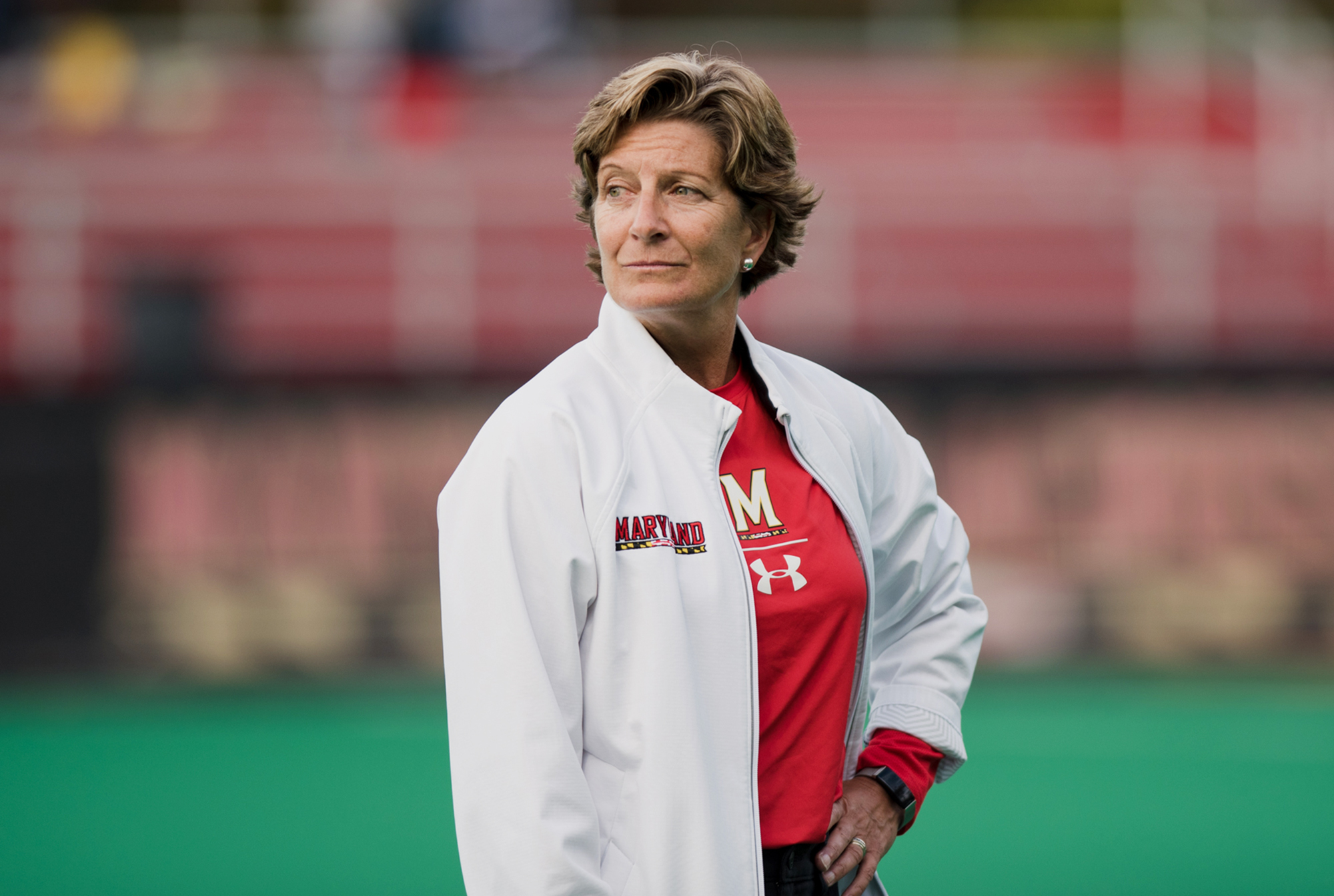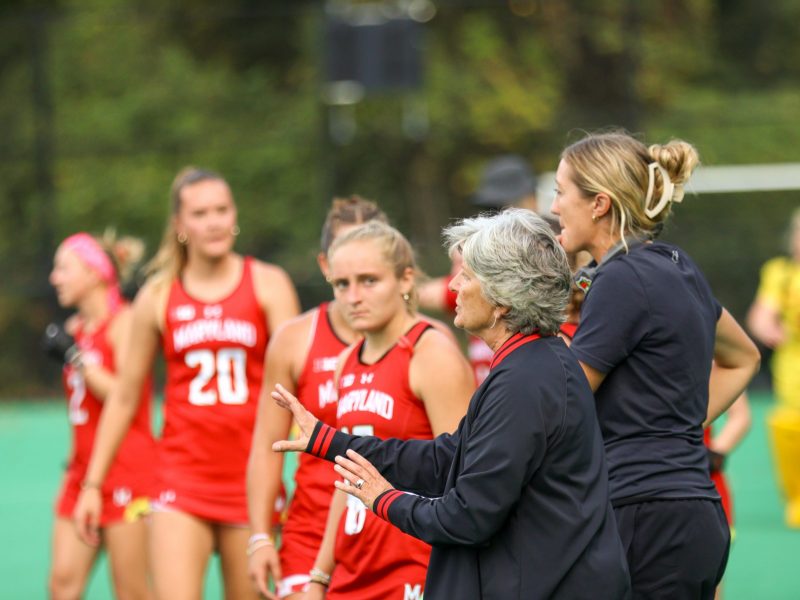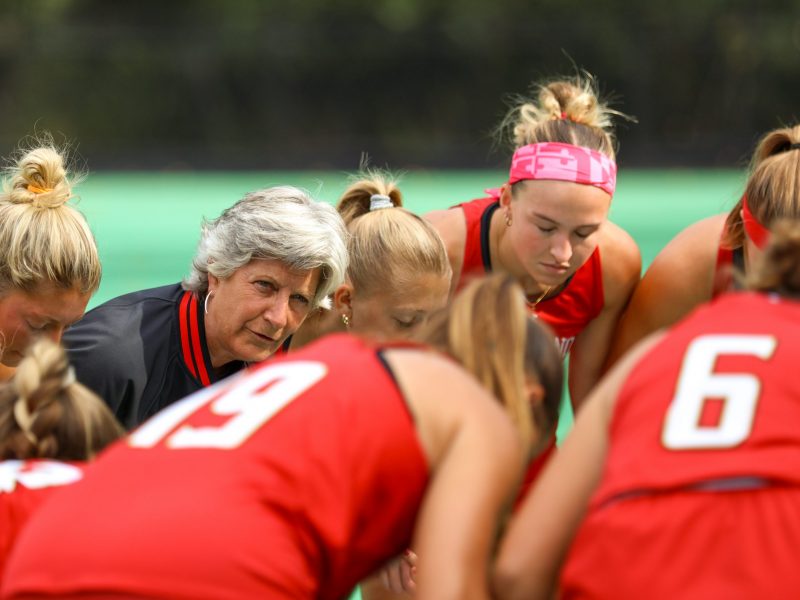It all started on Oct. 18, in biting Ann Arbor, Michigan conditions. It was the type of night where each breath was accompanied by a cloud of mist, where each participant’s arms and legs were polluted with goosebumps.
And as soon as Maryland field hockey wandered onto the Phyllis Ocker Field to take on then-No. 9 Michigan, it was clear that something was off. The Terps looked unimaginative in front of goal, and the Wolverines would soon capitalize on their torpidity, claiming a 1-0 victory courtesy of a splendid Guadalupe Fernandez Lacort run and finish.
At times, coach Missy Meharg’s squad was electric, pairing an imposing defensive unit that conceded less than a goal per game with a fluid attack that ranked among the nation’s most prolific.
But as the season reached its crescendo, Maryland’s offensive unit struggled to replicate its early-season impact. While the defense continued to impress, it was a lack of consistency in the attacking third of the pitch that consigned Maryland to a second-round exit in the NCAA tournament — the first time Maryland failed to reach the national championship game since 2016.
“We played a lot of different players in a lot of different positions, we opened up with a lot of different starters,” Meharg said after a season-ending loss to Virginia, “We seem[ed] to be a work in progress.”
[Read more: Noelle Frost’s journey with Maryland field hockey culminated in a career game vs. Virginia]
The Terps were dominant for much of the regular season, posting a 16-2 record including victories against five top-10 programs. However, Maryland’s offense stagnated toward the end of the season, mustering a combined fourteen shots on goal in its last two road games of the season.
The Terps carried their offensive woes into postseason play, suffering two shutouts in their last three games to dash any hopes of hoisting the wood-stained national championship trophy.
From the season’s onset, though, Meharg knew that Maryland would rely on depth up front, especially after losing two of its leading scorers from last season’s team, Linnea Gonzales and Nike Lorenz, as well as starting goalkeeper Sarah Holliday.
“We definitely will miss them,” defender Bodil Keus said before the season’s start, “but I think we have some good replacements for them. Our freshmen are upcoming — getting their roles — and a couple of our sophomores and juniors are standing up right now.”
[Read more: Maryland field hockey’s season ends with 1-0 OT loss to Virginia in NCAA tournament]
And after breezing through its opening weekend, Maryland had a perfect chance to showcase its quality throughout the squad, taking on ACC luminaries No. 13 Boston College and No. 3 Duke in the Big Ten/ACC Cup.
Newcomers Emma DeBerdine and Linda Cobano netted their first career goals in the Sept. 6 matchup against the Eagles, pushing Maryland to a 3-1 victory and foreshadowing a series of impressive displays by the attacking tandem.
“We got good players off the bench and into the game,” Meharg said after the win. “The new players are really coming into their own.”
And despite a tight game resulting in 1-0 defeat to the Blue Devils, the Terps were buoyed by a developing faith in their depth, reeling off a 10-game winning streak after losing to Duke.
One of those victories was a 3-2 shootout win over then-No. 6 Virginia — a shootout dominated by senior goalkeeper Noelle Frost, who made a number of diving saves to propel the Terps to a dramatic comeback victory.
“It was mental — mind over matter,” Frost said after the shootout, “I don’t care what’s happening, I’m saving this ball.”
And the Sep. 24 matchup against then-No. 10 Princeton played out at a similarly fervent intensity, with the Terps claiming a decisive 4-3 overtime victory through defender Hannah Bond and her fall-away buzzer-beating goal.
“Even though she’s not a senior, … I think a lot of the younger girls see the effort and 110 percent that she gives — especially the young defenders, the screens, and the midfielders,” forward Madison Maguire said. “They just want to do that for her as well.”
As the season progressed, it became clear that Maryland’s backline — featuring Frost, Keus, Bond, Riley Donnelly, and converted midfielder Nathalie Fiechter — was the foundation for Maryland’s success, conceding just 18 goals in 21 games.
Keus and Frost were particularly impressive, bringing stability and organization into an oft-rotated squad.
“The one constant for the whole year was Bodil and Noelle,” Meharg said, “If I were to put a stamp on how we did as well as we did and how we put ourselves in position to go to the final four, it would be Noelle and Bo.”
Frost — a redshirt senior who entered the season with 11 appearances under her belt — dazzled in the No. 1 jersey, holding the second-best save percentage (.806) and goals-against average (.870) and tied for the fourth-best win total (17) in the country on the season.
Meanwhile, Keus led Maryland’s outfield players in minutes, shots, and shots on goal en route a second-consecutive Big Ten Defensive Player of the Year award.
With the defense proving impenetrable for large portions of the season, Maryland’s attack had space to flourish. The triumvirate of DeBerdine, Cobano, and Maguire — the Big Ten’s Offensive Player of the Year — combined for nearly half of Maryland’s 62 goals.
But the wheels started to fall off on that frigid night at Phyllis Ocker Field, a night the Terps — despite plenty of endeavor — failed to mount a true challenge on Anna Spieker’s cage.
An inspired second-half road rally against a talented, albeit inexperienced, then-No. 21 Ohio State papered over the cracks — Meharg’s squad recorded just one shot in the entire second quarter.
“For us, though, we want to stop fooling around,” Meharg said on Oct. 20, “we have to get on the field and dominate.”
But Maryland’s display in the Big Ten tournament proved that these offensive concerns were far from a fluke.
The Terps took on Penn State on Nov. 8, an underachieving side that started the season with seven straight losses, including a 3-1 defeat at the hands of the Terps on Sep. 20. Yet it was the Nittany Lions who looked more commanding in the attack, taking an early lead and defending in numbers to limit Maryland’s attacking threat.
The result: A 1-0 defeat and an early trip back to College Park.
“It was definitely a disappointing outcome,” forward Jen Bleakney said. “We really had a lot of chances in the game that just didn’t end up going our way.”
Still, the NCAA tournament remained, and after thrashing Saint Joseph’s and its high-powered attack 4-0, Meharg’s squad seemed to have finally resolved its offensive impotence as it turned its attention to the Cavaliers.
Yet Maryland’s deficiencies reared themselves one final time in Charlottesville, as the attack failed to test a well-drilled Cavaliers back four, falling to a familiar 1-0 scoreline in overtime and bringing Maryland’s season to a premature end.
“As soon as we got into the tent [after the game], a couple teammates stood up and said what they thought about the season, including me,” Keus said on Nov. 17. “I really think we put our hearts out there — we left it on the field … we did that every [game] and I felt very proud.”
Despite their end-of-season offensive wobbles, the Terps are entering their offseason with optimism, bringing back nine starters from this season’s squad.
There will be difficulties, of course, with Maguire and Lepage — NFHCA All-Mid Atlantic Region First and Second Team honorees — graduating.
However, DeBerdine — voted to first team all-Big Ten — and Cobano are poised to add to their attacking capabilities after breaking through in their first seasons in College Park. Fellow forwards Mayv Clune and Kyler Greenwalt — dynamic attackers who struggled with knee injuries over the past couple seasons — will also look to supplant Maguire’s production after coming on strong toward the end of the campaign.
Meharg’s reputation as a Hall of Fame-coach precedes her, and the Terps certainly find themselves in a more enviable position than last offseason when they had to replace the production of five players who amassed at least 700 minutes of gametime.
For all of the talent that will be present on Meharg’s squad next season, though, there will be question marks. Maryland hasn’t won a national championship since 2011, and its underwhelming performance in front of the cage during the postseason is sure to ring in the minds of opponents who prepare to face the Terps.
Still, Maryland — fueled by a strong defensive nucleus and frustration after its postseason toils — is set to compete for the ultimate prize again in 2020.
“Our motivation … is this moment,” Keus said after the Virginia defeat. “We need to feed off of how we played [this season.] … We need to be on the same level.”



